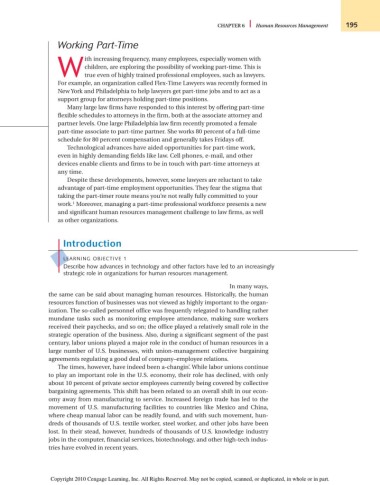Page 221 - Introduction to Business
P. 221
CHAPTER 6 Human Resources Management 195
Working Part-Time
ith increasing frequency, many employees, especially women with
children, are exploring the possibility of working part-time. This is
W true even of highly trained professional employees, such as lawyers.
For example, an organization called Flex-Time Lawyers was recently formed in
New York and Philadelphia to help lawyers get part-time jobs and to act as a
support group for attorneys holding part-time positions.
Many large law firms have responded to this interest by offering part-time
flexible schedules to attorneys in the firm, both at the associate attorney and
partner levels. One large Philadelphia law firm recently promoted a female
part-time associate to part-time partner. She works 80 percent of a full-time
schedule for 80 percent compensation and generally takes Fridays off.
Technological advances have aided opportunities for part-time work,
even in highly demanding fields like law. Cell phones, e-mail, and other
devices enable clients and firms to be in touch with part-time attorneys at
any time.
Despite these developments, however, some lawyers are reluctant to take
advantage of part-time employment opportunities. They fear the stigma that
taking the part-timer route means you’re not really fully committed to your
1
work. Moreover, managing a part-time professional workforce presents a new
and significant human resources management challenge to law firms, as well
as other organizations.
Introduction
LEARNING OBJECTIVE 1
Describe how advances in technology and other factors have led to an increasingly
strategic role in organizations for human resources management.
2
The famous Bob Dylan song goes “The times they are a-changin’.” In many ways,
the same can be said about managing human resources. Historically, the human
resources function of businesses was not viewed as highly important to the organ-
ization. The so-called personnel office was frequently relegated to handling rather
mundane tasks such as monitoring employee attendance, making sure workers
received their paychecks, and so on; the office played a relatively small role in the
strategic operation of the business. Also, during a significant segment of the past
century, labor unions played a major role in the conduct of human resources in a
large number of U.S. businesses, with union-management collective bargaining
agreements regulating a good deal of company–employee relations.
The times, however, have indeed been a-changin’. While labor unions continue
to play an important role in the U.S. economy, their role has declined, with only
about 10 percent of private sector employees currently being covered by collective
bargaining agreements. This shift has been related to an overall shift in our econ-
omy away from manufacturing to service. Increased foreign trade has led to the
movement of U.S. manufacturing facilities to countries like Mexico and China,
where cheap manual labor can be readily found, and with such movement, hun-
dreds of thousands of U.S. textile worker, steel worker, and other jobs have been
lost. In their stead, however, hundreds of thousands of U.S. knowledge industry
jobs in the computer, financial services, biotechnology, and other high-tech indus-
tries have evolved in recent years.
Copyright 2010 Cengage Learning, Inc. All Rights Reserved. May not be copied, scanned, or duplicated, in whole or in part.

